Effects of Y2O3 and LiAl5O8 on the Microstructure and Optical Properties of Reactively Sintered AlON Based Transparent Ceramics
Abstract
:1. Introduction
2. Experiments
2.1. Composition Design and Ceramic Fabrication
2.2. Materials Characterization
3. Results and Discussion
3.1. Sintering and Densification
3.2. Phase and Microstructural Evolution
3.3. Optical Properties and Material Structure
4. Conclusions
- (1)
- For the Y2O3 doped systems, pores could be effectively removed at the early sintering stage (1500–1650 °C); the densification was promoted by grain coarse at this stage. However, the densification was prohibited at a higher temperature accomplished by volume expansion, and large residual pores resulted from chemical reaction;
- (2)
- For the LA doped systems, pores could not be effectively removed at the early sintering stage (1500–1650 °C); the densification was prohibited by LA at this stage. The densification was promoted at a higher temperature. Composition with a higher LA content (20 wt%) showed a continuous densification during the sintering;
- (3)
- The chemical structure of the materials was not obviously affected by different dopants. Pores were the main contribution for the difference between the samples;
- (4)
- A larger size of Li: AlON transparent ceramic via reaction sintering method was obtained using 20 wt% LA doping. The ceramic has a pore-free microstructure and excellent optical transmittance (~86.8% at ~3.5 μm).
Author Contributions
Funding
Institutional Review Board Statement
Informed Consent Statement
Data Availability Statement
Acknowledgments
Conflicts of Interest
References
- Goldman, L.M.; Twedt, R.; Balasubramanian, S.; Sastri, S. ALON optical ceramic transparencies for window, dome, and transparent armor applications. In Proceedings of the Window and Dome Technologies and Materials XII, Orlando, FL, USA, 25–29 April 2011; Volume 8016, p. 801608. [Google Scholar] [CrossRef]
- Goldman, L.M.; Balasubramanian, S.; Kashalikar, U.; Foti, R.; Sastri, S. Scale up of large ALON windows. In Proceedings of the Window and Dome Technologies and Materials XIII, Baltimore, MD, USA, 29 April–3 May 2013; Volume 8078, p. 807804. [Google Scholar]
- Yamaguchi, G.; Yanagida, H. Study on the reductive spinel–A new spinel formula AlN–Al2O3 instead of the previous one Al3O4. Bull. Chem. Soc. Jpn. 1959, 32, 1264–1265. [Google Scholar] [CrossRef] [Green Version]
- Tabary, P.; Servant, C. Thermodynamic reassessment of the AlN–Al2O3 system. Calphad 1998, 22, 179–201. [Google Scholar] [CrossRef]
- Wang, S.; Zhang, J.; Luo, D.; Gu, F.; Tang, D.; Dong, Z.; Tan, G.; Que, W.; Zhang, T.; Li, S.; et al. Transparent ceramics: Processing, materials and applications. Prog. Solid State Chem. 2013, 41, 20–54. [Google Scholar] [CrossRef]
- Wang, L.; Xie, R.-J.; Suehiro, T.; Takeda, T.; Hirosaki, N. Down-conversion nitride materials for solid state lighting: Recent advances and perspectives. Chem. Rev. 2018, 118, 1951–2009. [Google Scholar] [CrossRef]
- Willems, H.; Hendrix, M.; Metselaar, R.; de With, G. Thermodynamics of Alon I: Stability at lower temperatures. J. Eur. Ceram. Soc. 1992, 10, 327–337. [Google Scholar] [CrossRef] [Green Version]
- McCauley, J.W.; Corbin, N.D. Phase Relations and Reaction Sintering of Transparent Cubic Aluminum Oxynitride Spinel (ALON). J. Am. Ceram. Soc. 1979, 62, 476–479. [Google Scholar] [CrossRef]
- Tsabit, A.M.; Kim, M.-D.; Yoon, D.-H. Effects of various rare-earth additives on the sintering and transmittance of γ-AlON. J. Eur. Ceram. Soc. 2020, 40, 3235–3243. [Google Scholar] [CrossRef]
- Zhang, F.; Yuan, X.; Wang, S.; Wang, S. Preparation and luminescence properties of Eu2+ doped γ-aluminum oxynitride transparent ceramics. J. Lumin. 2013, 133, 200–202. [Google Scholar] [CrossRef]
- Feng, Z.; Qi, J.; Guo, X.; Wang, Y.; Cao, X.; Yu, Y.; Meng, C.; Lu, T. A new and highly active sintering additive: SiO2 for highly-transparent AlON ceramic. J. Alloys Compd. 2019, 787, 254–259. [Google Scholar] [CrossRef]
- Chen, C.-F.; Yang, P.; King, G.; Tegtmeier, E.L. Processing of Transparent Polycrystalline AlON: Ce3+ Scintillators. J. Am. Ceram. Soc. 2016, 99, 424–430. [Google Scholar] [CrossRef]
- Miller, L.; Kaplan, W.D. Solubility limits of La and Y in aluminum oxynitride at 1870 °C. J. Am. Ceram. Soc. 2008, 91, 1693–1696. [Google Scholar] [CrossRef]
- Wang, J.; Zhang, F.; Chen, F.; Zhang, J.; Zhang, H.; Tian, R.; Wang, Z.; Liu, J.; Zhang, Z.; Chen, S.; et al. Effect of Y2O3 and La2O3 on the sinterability of γ-AlON transparent ceramics. J. Eur. Ceram. Soc. 2015, 35, 23–28. [Google Scholar] [CrossRef]
- Jiang, N.; Liu, Q.; Xie, T.; Ma, P.; Kou, H.; Pan, Y.; Li, J. Fabrication of highly transparent AlON ceramics by hot isostatic pressing post-treatment. J. Eur. Ceram. Soc. 2017, 37, 4213–4216. [Google Scholar] [CrossRef]
- Li, X.; Luo, J.; Zhou, Y. Spark plasma sintering behavior of AlON ceramics doped with different concentrations of Y2O3. J. Eur. Ceram. Soc. 2015, 35, 2027–2032. [Google Scholar] [CrossRef]
- Zhou, D.; Qi, H.; Zhou, B.; Wang, Y.; Zhou, Z.; Wang, L.; Xu, J.; Shi, Y. Mixed precipitants derived nanocrystalline powders and RE doped LuAG transparent ceramics. Ceram. Int. 2022, 48, 24788–24792. [Google Scholar] [CrossRef]
- Chen, P.; Li, X.; Tian, F.; Liu, Z.; Hu, D.; Xie, T.; Liu, Q.; Li, J. Fabrication, microstructure, and properties of 8 mol% yttria-stabilized zirconia (8YSZ) transparent ceramics. J. Adv. Ceram. 2022, 11, 1153–1162. [Google Scholar] [CrossRef]
- Willems, H.; de With, G.; Metselaar, R. Thermodynamics of Alon III: Stabilization of Alon with MgO. J. Eur. Ceram. Soc. 1993, 12, 43–49. [Google Scholar] [CrossRef] [Green Version]
- Granon, A.; Goeuriot, P.; Thevenot, F. Reactivity in the Al2O3–AlN–MgO system. The MgAlON spinel phase. J. Eur. Ceram. Soc. 1994, 13, 365–370. [Google Scholar] [CrossRef]
- Liu, X.; Wang, H.; Tu, B.T.; Wang, W.M.; Fu, Z.Y. Highly transparent Mg0.27Al2.58O3.73N0.27 ceramic prepared by pressureless sintering. J. Am. Ceram. Soc. 2014, 97, 63–66. [Google Scholar] [CrossRef]
- Huang, J.; Hussain, M.I.; Lv, X.; Dong, X.; Xu, E. Preparation and high-temperature oxidation behaviors of MgAl2O4-MgAlON composites by in-situ nitriding. J. Alloys Compd. 2022, 909, 164648. [Google Scholar] [CrossRef]
- Liu, R.; Zhang, X.Y.; Wang, X.J.; Gao, F.; Lv, Q. Mechanical Properties of BN–MgAlON Composites Prepared by Hot-pressing Sintering. J. Synth. Cryst. 2015, 44, 2290–2297. [Google Scholar]
- Clay, D.; Poslusny, D.; Flinders, M.; Jacobs, S.D.; Cutler, R.A. Effect of LiAl5O8 additions on the sintering and optical transparency of LiAlON. J. Eur. Ceram. Soc. 2006, 26, 1351–1362. [Google Scholar] [CrossRef]
- Ikesue, A.; Aung, Y.L. Ceramic laser materials. Nat. Photonics 2008, 2, 721–727. [Google Scholar] [CrossRef]
- Krell, A.; Klimke, J.; Hutzler, T. Transparent compact ceramics: Inherent physical issues. Opt. Mater. 2009, 31, 1144–1150. [Google Scholar] [CrossRef]
- Zhang, R.; Wang, Y.; Tian, M.; Wang, H. Highly transparent LiAlON ceramic prepared by reaction sintering and post hot isostatic pressing. J. Eur. Ceram. Soc. 2018, 38, 5252–5256. [Google Scholar] [CrossRef]
- Shi, Z.; Wang, Y.; Yang, G.; Li, H.; Deng, L.; Tian, M.; Liu, M.; Nishimura, K.; Jiang, N. A comparison of the properties of AlON and LiAlON transparent ceramics prepared by reaction sintering and hot isostatic pressing. Ceram. Int. 2022, 48, 10096–10104. [Google Scholar] [CrossRef]
- Ikeda, Y.; Ito, H.; Matsumoto, G.; Hayashi, H. The vaporization and thermochemical stability of lithium aluminates. J. Nucl. Mater. 1981, 97, 47–58. [Google Scholar] [CrossRef]
- Min, J.-H.; Li, J.; Yoon, D.-H. Fabrication of transparent γ-AlON by direct 2-step pressureless sintering of Al2O3 and AlN using an AlN-deficient composition. J. Eur. Ceram. Soc. 2019, 39, 4673–4679. [Google Scholar] [CrossRef]
- Sousa, O.; Carvalho, I. The effect of Ce-doping on the structural, electronic and magnetic properties of LiAl5O8: A first-principles study. J. Solid State Chem. 2021, 303, 122474. [Google Scholar] [CrossRef]
- Bernard-Granger, G.; Benameur, N.; Guizard, C.; Nygren, M. Influence of graphite contamination on the optical properties of transparent spinel obtained by spark plasma sintering. Scr. Mater. 2009, 60, 164–167. [Google Scholar] [CrossRef]
- Stevenson, A.J.; Bittel, B.C.; Leh, C.G.; Li, X.; Dickey, E.C.; Lenahan, P.M.; Messing, G.L. Color center formation in vacuum sintered Nd3xY3−3xAl5O12 transparent ceramics. Appl. Phys. Lett. 2011, 98, 051906. [Google Scholar] [CrossRef]
- Shan, Y.; Zhang, Z.; Sun, X.; Xu, J.; Qin, Q.; Li, J. Fast densification mechanism of bimodal powder during pressureless sintering of transparent AlON ceramics. J. Eur. Ceram. Soc. 2016, 36, 671–678. [Google Scholar] [CrossRef]
- Bandyopadhyay, S.; Rixecker, G.; Aldinger, F.; Pal, S.; Mukherjee, K.; Maiti, H.S. Effect of reaction parameters on γ-AlON formation from Al2O3 and AlN. J. Am. Ceram. Soc. 2004, 85, 1010–1012. [Google Scholar] [CrossRef]
- Li, H.; Min, P.; Song, N.; Zhang, A.; Zhou, J.; Xian, H.; Liu, H.; Fang, J. Rapid synthesis of AlON powders by low temperature solid-state reaction. Ceram. Int. 2019, 45, 8188–8194. [Google Scholar] [CrossRef]
- Shan, Y.; Sun, X.; Ren, B.; Wu, H.; Wei, X.; Olevsky, E.A.; Xu, J.; Li, J. Pressureless sintering of highly transparent AlON ceramics with CaCO3 doping. Scr. Mater. 2018, 157, 148–151. [Google Scholar] [CrossRef]
- Guo, H.; Mao, X.; Zhang, J.; Tian, R.; Wang, S. Densification of AlON ceramics doped with Y2O3-La2O3-MnO additives at lower sintering temperature. Ceram. Int. 2019, 45, 5080–5086. [Google Scholar] [CrossRef]
- Hartnett, T.; Bernstein, S.; Maguire, E.; Tustison, R. Optical properties of ALON (aluminum oxynitride). Infrared Phys. Technol. 1998, 39, 203–211. [Google Scholar] [CrossRef]
- Corbin, N.D. Aluminum oxynitride spinel: A review. J. Eur. Ceram. Soc. 1989, 5, 143–154. [Google Scholar] [CrossRef]
- Chen, H.-Y.; Lu, H.-L.; Chen, J.-X.; Zhang, F.; Ji, X.-M.; Liu, W.-J.; Yang, X.-F.; Zhang, D.W. Low-Temperature One-Step Growth of AlON Thin Films with Homogenous Nitrogen-Doping Profile by Plasma-Enhanced Atomic Layer Deposition. ACS Appl. Mater. Interfaces 2017, 9, 38662–38669. [Google Scholar] [CrossRef]
- Venezia, A.M.; Bertoncello, R.; Deganello, G. X-ray photoelectron spectroscopy investigation of pumice-supported nickel catalysts. Surf. Interface Anal. 1995, 23, 239–247. [Google Scholar] [CrossRef]
- Li, Y.; Zhang, C.; Luo, X.; Liang, Y.; Wuu, D.-S.; Tin, C.-C.; Lu, X.; He, K.; Wan, L.; Feng, Z.C. Surface, structural and optical properties of AlN thin films grown on different face sapphire substrates by metalorganic chemical vapor deposition. Appl. Surf. Sci. 2018, 458, 972–977. [Google Scholar] [CrossRef]
- Zhang, J.X.; Liang, L.; Gao, L.Q. Study on MgAl2O4-doped Al2O3 ceramics. Rare Met. Mater. Eng. 2005, 34, 348–351. [Google Scholar]
- Stevenson, A.J.; Kupp, E.R.; Messing, G.L. Low temperature, transient liquid phase sintering of B2O3-SiO2-doped Nd:YAG transparent ceramics. J. Mater. Res. 2011, 26, 1151–1158. [Google Scholar] [CrossRef]
- Hostaša, J.; Cova, F.; Piancastelli, A.; Fasoli, M.; Zanelli, C.; Vedda, A.; Biasini, V. Fabrication and luminescence of Ce-doped GGAG transparent ceramics, effect of sintering parameters and additives. Ceram. Int. 2019, 45, 23283–23288. [Google Scholar] [CrossRef]
- Al-Gaashani, R.; Najjar, A.; Zakaria, Y.; Mansour, S.; Atieh, M.A. XPS and structural studies of high quality graphene oxide and reduced graphene oxide prepared by different chemical oxidation methods. Ceram. Int. 2019, 45, 14439–14448. [Google Scholar] [CrossRef]
- Rasheed, M.; Barillé, R. Comparison the optical properties for Bi2O3 and NiO ultrathin films deposited on different substrates by DC sputtering technique for transparent electronics. J. Alloys Compd. 2017, 728, 1186–1198. [Google Scholar] [CrossRef] [Green Version]
- Kadri, E.; Dhahri, K.; Zaafouri, A.; Krichen, M.; Rasheed, M.; Khirouni, K.; Moltech-Anjou, R.B. Ac conductivity and dielectric behavior of a − Si: H/c − Si1−y Gey/p − Si thin films synthesized by Molecular Beam Epitaxial method. J. Alloys Compd. 2017, 705, 708–713. [Google Scholar] [CrossRef]
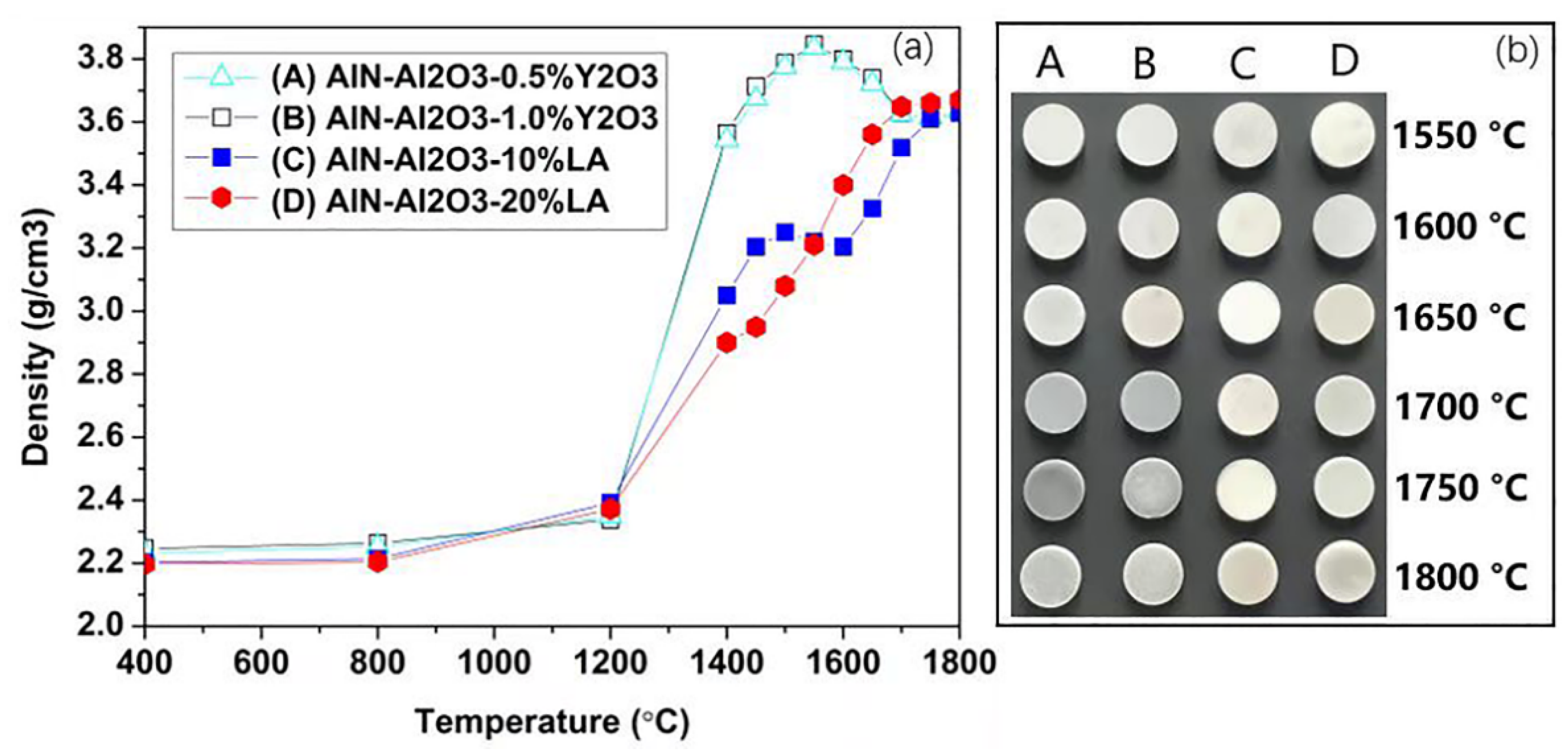

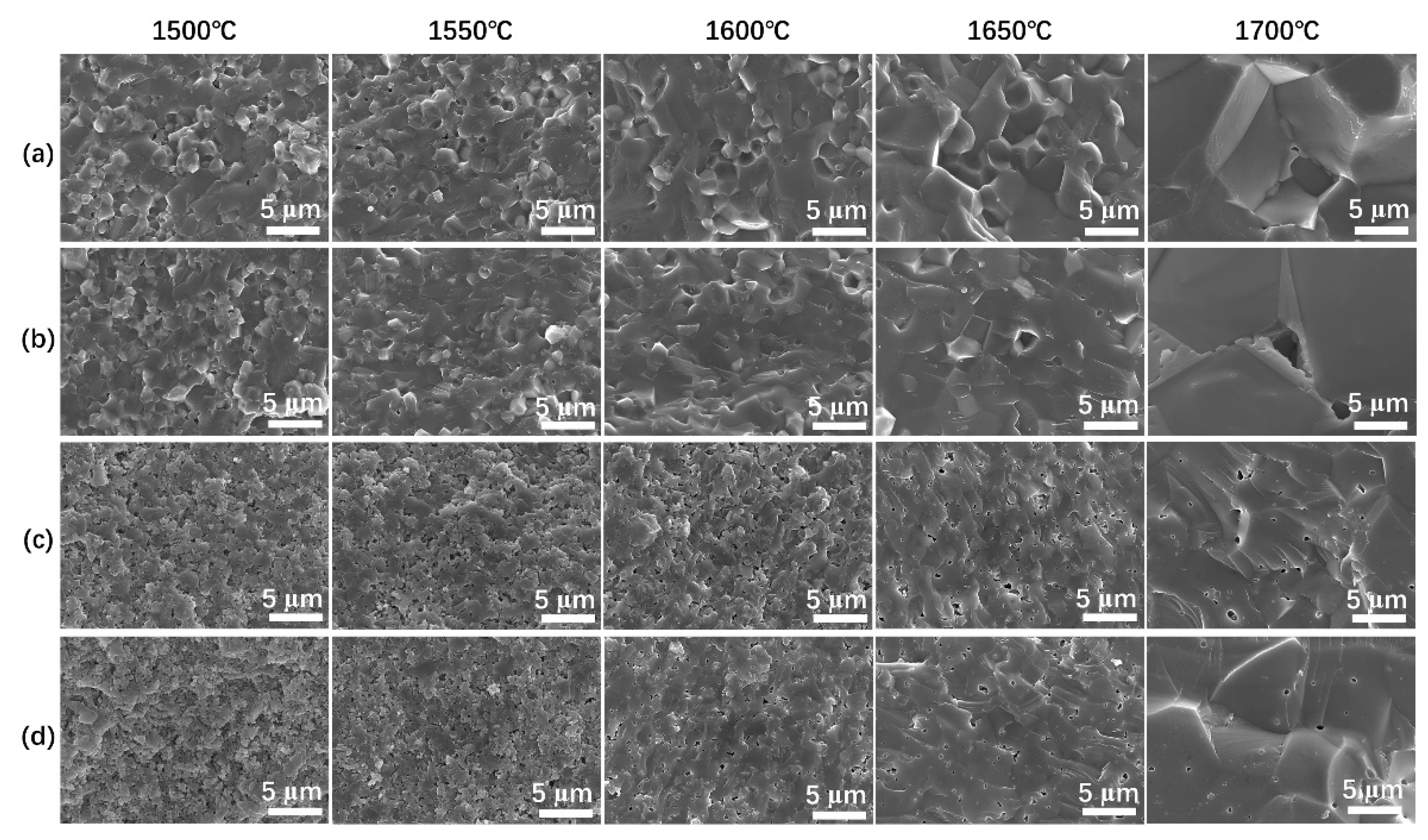
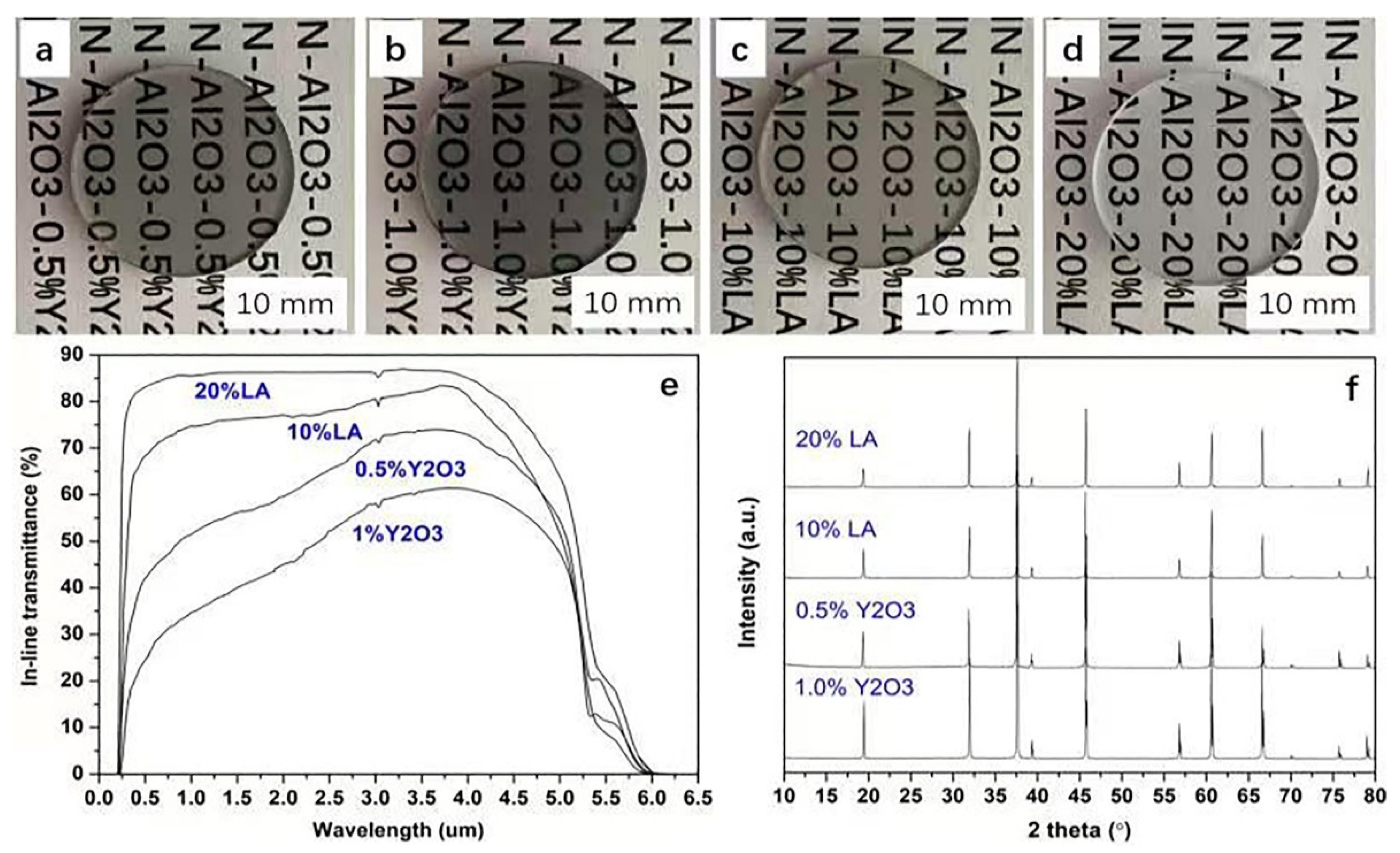
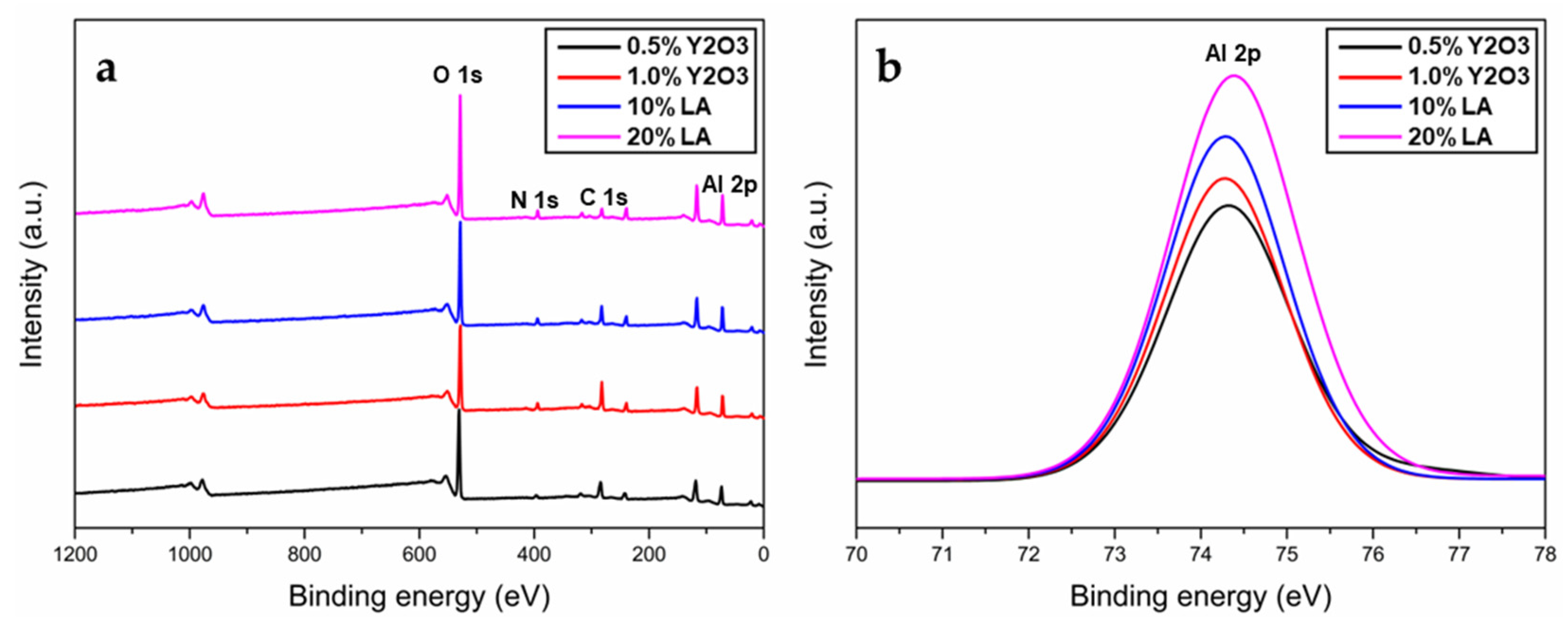

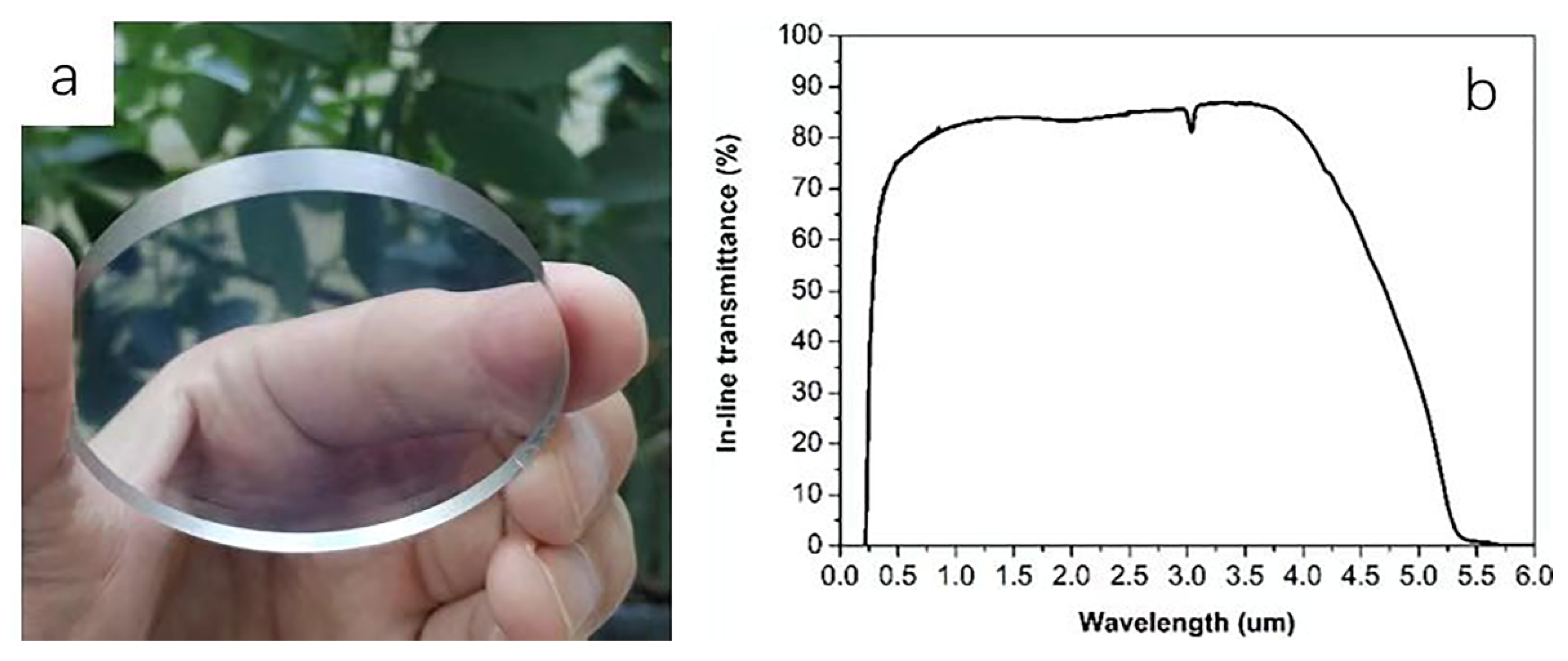
| Materials | A | B | C | D |
|---|---|---|---|---|
| AlN | 10% | 10% | 10% | 10% |
| Al2O3 | 90% | 90% | 80% | 70% |
| Y2O3 | 0.5% | 1% | - | - |
| LiAl5O8 | - | - | 10% | 20% |
| Theoretical density | 3.71 | 3.71 | 3.70 | 3.69 |
Publisher’s Note: MDPI stays neutral with regard to jurisdictional claims in published maps and institutional affiliations. |
© 2022 by the authors. Licensee MDPI, Basel, Switzerland. This article is an open access article distributed under the terms and conditions of the Creative Commons Attribution (CC BY) license (https://creativecommons.org/licenses/by/4.0/).
Share and Cite
Yang, G.; Sun, P.; Wang, Y.; Shi, Z.; Yan, Q.; Li, S.; Yang, G.; Yang, K.; Dun, S.; Shang, P.; et al. Effects of Y2O3 and LiAl5O8 on the Microstructure and Optical Properties of Reactively Sintered AlON Based Transparent Ceramics. Materials 2022, 15, 8036. https://doi.org/10.3390/ma15228036
Yang G, Sun P, Wang Y, Shi Z, Yan Q, Li S, Yang G, Yang K, Dun S, Shang P, et al. Effects of Y2O3 and LiAl5O8 on the Microstructure and Optical Properties of Reactively Sintered AlON Based Transparent Ceramics. Materials. 2022; 15(22):8036. https://doi.org/10.3390/ma15228036
Chicago/Turabian StyleYang, Guojian, Peng Sun, Yuezhong Wang, Zitao Shi, Qingwei Yan, Shasha Li, Guoyong Yang, Ke Yang, Shijie Dun, Peng Shang, and et al. 2022. "Effects of Y2O3 and LiAl5O8 on the Microstructure and Optical Properties of Reactively Sintered AlON Based Transparent Ceramics" Materials 15, no. 22: 8036. https://doi.org/10.3390/ma15228036
APA StyleYang, G., Sun, P., Wang, Y., Shi, Z., Yan, Q., Li, S., Yang, G., Yang, K., Dun, S., Shang, P., Deng, L., Li, H., & Jiang, N. (2022). Effects of Y2O3 and LiAl5O8 on the Microstructure and Optical Properties of Reactively Sintered AlON Based Transparent Ceramics. Materials, 15(22), 8036. https://doi.org/10.3390/ma15228036





